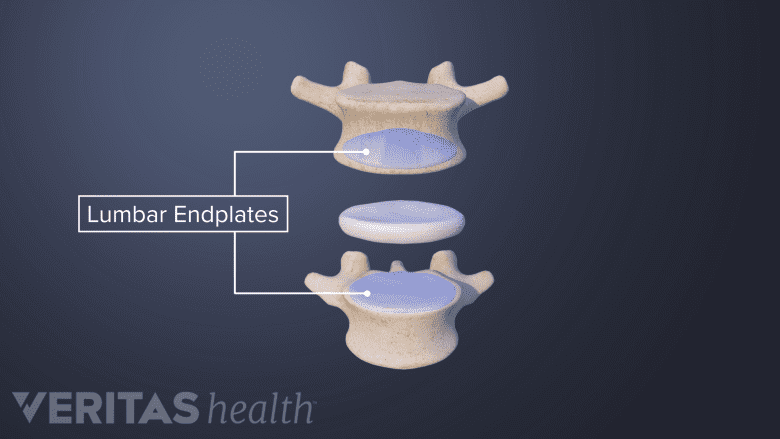The lumbar spine contains a total of 5 intervertebral discs situated between the vertebral bodies.
The primary functions of these discs are to1Cramer GD. General Characteristics of the Spine. In: Clinical Anatomy of the Spine, Spinal Cord, and Ans. Elsevier; 2014:15-64. doi:10.1016/b978-0-323-07954-9.00002-5:
- Distribute compressive loads placed on the spine, providing shock absorption properties
- Maintain the distance between the vertebral bodies during movement
- Provide flexibility to the spine and prevent excessive movements
- Create and maintain the lordotic (backward C-shaped) curve of the lumbar spine
The discs are typically named based on the vertebrae above and below it, for example, the L4-L5 disc.
In This Article:
Characteristics of the Lumbar Discs

The lumbar discs undergo changes in shape and size based on posture and activity level.
The lumbar intervertebral discs have the following distinguishing features2Cramer GD. The Lumbar Region. In: Clinical Anatomy of the Spine, Spinal Cord, and Ans. Elsevier; 2014:246-311. doi:10.1016/b978-0-323-07954-9.00007-4:
- Size. The lumbar intervertebral discs are the thickest compared to other spinal regions. The discs are also thicker in front than the back.
- Height. The lumbar discs become shorter during the day due to the weight of the upper body. It is estimated that sleeping for a minimum of 5 hours helps the discs regain their original shape.
- Shape. The form of the lumbar disc changes with movement. When the spine bends forward, the height in the front of the disc decreases while the posterior height increases. The opposite occurs while bending backward.
The discs are secured in place by the anterior (front) and posterior (back) longitudinal ligaments.1Cramer GD. General Characteristics of the Spine. In: Clinical Anatomy of the Spine, Spinal Cord, and Ans. Elsevier; 2014:15-64. doi:10.1016/b978-0-323-07954-9.00002-5
Composition of the Lumbar Discs

Spinal discs are composed of a tough outer layer and soft inner core.
While the overall composition of the lumbar discs is similar to other discs in the spine, there are a few differences.
The lumbar disc typically consists of1Cramer GD. General Characteristics of the Spine. In: Clinical Anatomy of the Spine, Spinal Cord, and Ans. Elsevier; 2014:15-64. doi:10.1016/b978-0-323-07954-9.00002-5:
- Annulus fibrosus. The outer shell of a lumbar disc is called the annulus fibrosus. This shell is thick and consists of several layers of tough collagen protein fibers, as opposed to a single layer seen in the discs of the neck. The annulus fibrosus provides the main shock-absorbing properties delivered by the disc.
- Nucleus pulposus. A softer type of collagen protein fills the central part of the lumbar disc, called the nucleus pulposus. The nucleus pulposus contains 70% to 90% of water and reaches its peak hydration between the ages of 20 to 30 years, following which, dehydration and degeneration begin to occur.
As age advances, the discs may get calcified (deposition of calcium) and hardened, reducing their flexibility.1Cramer GD. General Characteristics of the Spine. In: Clinical Anatomy of the Spine, Spinal Cord, and Ans. Elsevier; 2014:15-64. doi:10.1016/b978-0-323-07954-9.00002-5
Vertebral Endplates of the Lumbar Discs

Vertebral endplates are situated between the vertebral body and intervertebral disc.
A bi-layered vertebral endplate made of cortical bone and hyaline cartilage is attached to the upper and lower surfaces of the disc and binds the disc to the vertebral body. The bony portion of the endplate is attached to the vertebral body and helps resist compressive loads on the spine. The cartilaginous portion of the endplate helps contain the annulus fibrosus and nucleus pulposus within their normal anatomic borders.1Cramer GD. General Characteristics of the Spine. In: Clinical Anatomy of the Spine, Spinal Cord, and Ans. Elsevier; 2014:15-64. doi:10.1016/b978-0-323-07954-9.00002-5
The disc receives a majority of its nutrition through these endplates by absorbing fluids (similar to the action of a sponge) during spinal movements. Excessive forces and high-pressure postures, such as prolonged standing and sitting, can inhibit disc nutrition.1Cramer GD. General Characteristics of the Spine. In: Clinical Anatomy of the Spine, Spinal Cord, and Ans. Elsevier; 2014:15-64. doi:10.1016/b978-0-323-07954-9.00002-5
While the lumbar discs provide significant flexibility and protective functions, they are also highly susceptible to injury. In general, the front part of the disc is the strongest and the back and sides are weaker and susceptible to herniation and other disc disorders.1Cramer GD. General Characteristics of the Spine. In: Clinical Anatomy of the Spine, Spinal Cord, and Ans. Elsevier; 2014:15-64. doi:10.1016/b978-0-323-07954-9.00002-5 Research indicates that 90% of lumbar disc herniations occur at the L4-L5 or the L5-S1 disc space.3Donnally III CJ, Butler AJ, Varacallo M. Lumbosacral Disc Injuries. [Updated 2019 Apr 11]. In: StatPearls [Internet]. Treasure Island (FL): StatPearls Publishing; 2019 Jan-. Available from: https://www.ncbi.nlm.nih.gov/books/NBK448072/
Read more about Causes of Lower Back Pain
- 1 Cramer GD. General Characteristics of the Spine. In: Clinical Anatomy of the Spine, Spinal Cord, and Ans. Elsevier; 2014:15-64. doi:10.1016/b978-0-323-07954-9.00002-5
- 2 Cramer GD. The Lumbar Region. In: Clinical Anatomy of the Spine, Spinal Cord, and Ans. Elsevier; 2014:246-311. doi:10.1016/b978-0-323-07954-9.00007-4
- 3 Donnally III CJ, Butler AJ, Varacallo M. Lumbosacral Disc Injuries. [Updated 2019 Apr 11]. In: StatPearls [Internet]. Treasure Island (FL): StatPearls Publishing; 2019 Jan-. Available from: https://www.ncbi.nlm.nih.gov/books/NBK448072/

